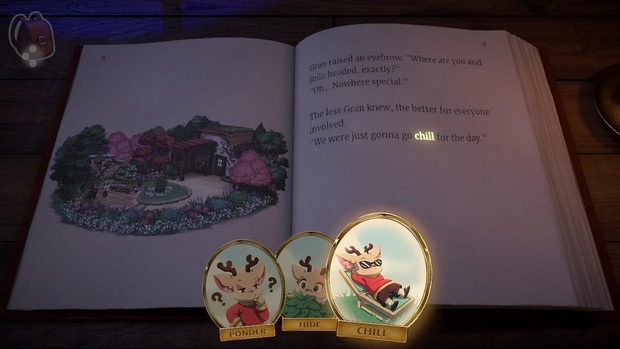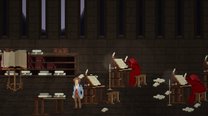Beacon Pines review

- 0 Comments
Charming visual novel-styled animal adventure features clever branching path mechanic to dig deeper
There’s just something about charming small towns full of dark secrets and sinister conspiracies. Maybe it’s the dissonance between the cozy familiarity of a sparsely populated, tight-knit community where everyone knows your name, and the sinking realization that the pleasantries are masking something far more menacing. Beacon Pines is a game that pushes this dissonance even further by populating its titular little town with adorable, anthropomorphized animals. It has shades of Stranger Things and Twin Peaks, but it carves out its own identity with fantastic art and music, an interesting and well-rounded cast, and an effective, nicely written mystery.
Beacon Pines uses a storybook framing device, with a narrator introducing you to the tale as you crack open the book and begin the first chapter. We follow Luka VanHorn, a young deer boy first introduced mourning at his father’s grave. Soon he’s interrupted by his energetic tiger friend Rolo, and it’s revealed that Luka is effectively an orphan, now living with his grandma after the disappearance of his mother. Through Luka’s interactions with the other townsfolk, we slowly begin to learn more about Beacon Pines itself, a former mining outpost now struggling six years after a mysterious accident called the Foul Harvest shut down its biggest source of revenue. But the economic downturn is far from the town’s only problem: strange earthquakes, disappearances, and puddles of toxic glowing goo are becoming more and more frequent. Worst of all, none of the adults seem to acknowledge that something is very wrong.
The world you’ll explore is presented with cartoony 2D sprites against isometric painted backgrounds. Interacting with people and objects in the environment (all helpfully denoted with a little magnifying glass icon when you approach them) allows you to collect Charms. Charms are words added to your bag (which also features a reminder of your current objective) upon discovery; the first three to be found are “ponder,” “chill,” and “tickle.” Shortly after you find your first few Charms, the narrator introduces the main gameplay mechanic: at certain times throughout the story you will reach Turning Points, which are moments when you are able to use the Charms you’ve collected to change the story.

At these moments, you’ll be returned to the storybook and shown a sentence ending in a blank space, and you must choose a Charm to decide how the story will branch. The first Turning Point you reach is simple and without any major consequences: Luka’s grandmother asks what he and Rolo are planning to do, and you’re given the choice between “ponder” and “chill.” Once you’ve made your choice, the rest of the sentence fills in on the page before you are transported back into the world to see how other characters react to your decision.
These choices aren’t necessarily permanent, however. You’re able to return to a Turning Point and try a different Charm by entering The Chronicle, an image of a tree with glowing points to represent each choice you’ve been given so far. You can access it at any time from an on-screen icon to review the paths you’ve already taken, but you’ll really only need to visit other Turning Points when you hit a dead end on your current path. When you select a point on the tree, you’ll be able to see which Charms you can use there and which you’ve already tried. As you progress and collect more Charms, you can sometimes return to earlier points in the game and change the narrative again—in fact, the narrator encourages this, reminding you that “a single word can change everything.” What makes these branching choices enjoyable is that each path offers more than simply a few lines of changed dialogue. You’re often getting entirely new scenes with each decision you make.
Returning to past Turning Points, making different choices and changing the story’s outcome is central to progress. Luka meets his first dead end before too long, a moment used to demonstrate the multiple branching paths available, though we’re told that “most end in tragedy.” The nature of The Chronicle means that you can easily see every possible path and ending in one playthrough, and each new branch feels distinctive enough that repetition is limited. It should be mentioned that this game has a single true ending, with the different outcomes serving more as bonus scenes than actual endings or alternate paths the story can take. The secondary narrative branches are still worth experiencing, introducing you to different characters and additional backstory, but they do all end up as either a tragic, incomplete end or just a different path to take you to the same finale.

Though the Charms mechanic is enjoyable and adds some interactivity, Beacon Pines plays more like a visual novel than anything else. There aren’t that many ways to interact with the environment outside of a few objects you have to examine to progress, with a few scattered extra items that provide some humor or additional worldbuilding upon inspection in traditional adventure game fashion. Fishing and restaurant serving minigames are brief variations in the gameplay, but they’re simple and fairly short. The fishing minigame asks you to choose a type of bait (using relevant Charms) and reel in a fish without breaking the line, releasing when it starts to shake. Waiting tables in the restaurant has Luka going from customer to customer, taking orders and memorizing them to prepare in the kitchen—“cooking” is just a matter of selecting the ingredients the customer ordered (once again selected from the Charms that represent each ingredient).
I played Beacon Pines with a gamepad, but you can also play with your keyboard (no mouse or touchscreen support here). There is one brief occasion when you have to throw an object in the air to hit a moving target, but that’s the most you can expect for any task requiring timing or dexterity.
In keeping with its storybook theme, aesthetically the game leans more cute than creepy, with appealing painted backgrounds and large overlaid character portraits when talking to others. Less plot-critical conversations appear in dialogue bubbles over the heads of the charming in-game 2D sprites. Simple animations bring the cast to life as you move through town (I especially liked the sneezing animation every time Luka walks through a clump of dandelions), and the fantastic visuals are complemented by an equally enjoyable soundtrack. Bright, upbeat piano melodies that accompany early scenes in the idyllic town are replaced by eerie synths and electric guitar as the plot grows darker and more intense. The score does an excellent job setting the mood and guiding players through the story’s changing tones.
The only vocals are courtesy of the narrator, whose excited, emotive voice sounds exactly like someone reading a picture book to a kid. It’s a good performance, but I felt that it was increasingly at odds with the more serious tone as the story progressed. Character dialogue is “voiced” with Animal Crossing-esque beep-boop chatter, with different tones and pitches setting each character apart. Given how much personality already comes through in the dialogue, I can imagine how much a full voice cast would have improved an already excellent narrative even further. Fortunately, the strong, personality-filled writing makes it easy to grow invested in the lives of the quirky animal cast—including my personal favorite, a bat named Dawn who works at the local newsstand and dreams of being a big shot journalist.
While the idea of a cozy rural town hiding dangerous characters and multigenerational conspiracies isn’t new, I was impressed with Beacon Pines’ storytelling. There are a lot of tropes here: a megacorporation popping up to disrupt the town’s old-school way of life; brave kids determined to get to the bottom of it all when the grown-ups won’t; even the whole concept of cute, cartoony characters in dark, eerie games. Still, I found the twists fun and the overall mystery engaging and well-written, with developments and reveals that genuinely surprised me. The characters are given welcome depth and development, and the story hits some genuinely emotional beats.
Final Verdict
There’s nothing in the way of puzzles here if challenge is what you’re looking for, but if you enjoy suspense-tinged mysteries set in quirky small towns—in this case with a cast of anthropomorphized cats and squirrels and lions harboring dark secrets and threatening conspiracies—this game will give you a good six or so hours of engaging storytelling with an excellent audio-visual presentation. I would have preferred full voice-overs and choices that mattered a bit more in the end, but even without them, I truly enjoyed the time I spent unraveling the mysteries of Beacon Pines.
Hot take
Gameplay and player agency may be limited, but as an interactive storybook, Beacon Pines is a charming, intriguing mystery with a great cast, gorgeous art, and a fun branching path mechanic.
Pros
- Beautiful art and music
- Well-written narrative grows increasingly ominous
- Enjoyable choice-based story-branching mechanic
Cons
- Only partial voice acting
- Many ways to finish the game but just one actual ending
Bryce played Beacon Pines on PC using a review code provided by the game's publisher.









0 Comments
Want to join the discussion? Leave a comment as guest, sign in or register in our forums.
Leave a comment